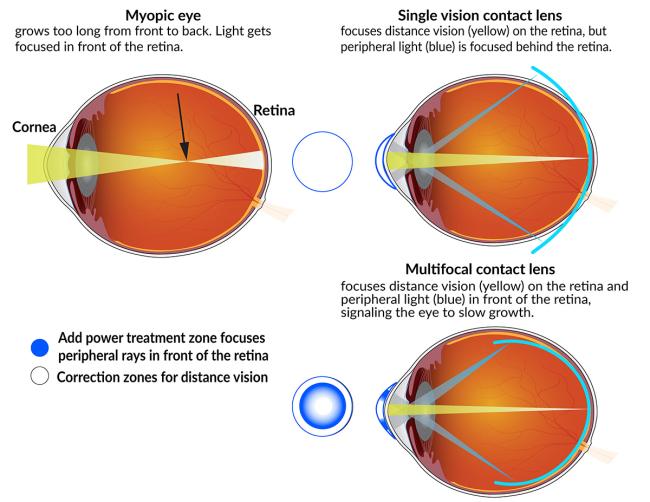Lasting effects of contact lenses that slow myopia in kids
February 18, 2025
Lasting effects of contact lenses that slow myopia in kids
At a Glance
- Multifocal contact lenses slowed progression of nearsightedness in children, and the treatment benefit continued even after they stopped wearing the lenses.
- The finding suggests a successful long-term treatment strategy for using multifocal contact lenses to control myopia.

Nearsightedness, or myopia, makes faraway objects look blurry. It usually arises during childhood, when developing eyes grow too long from front to back. This lengthening keeps images from focusing directly on the retina, the light-sensitive tissue in the back of the eye. Instead, distant objects focus at a point in front of the retina, causing them to appear blurred. Severe, or high, myopia can also raise the risk of developing vision-related complications later in life, such as glaucoma or retinal detachment.
Single-vision prescription glasses and contact lenses can reduce the blurry images caused by myopia. But they don’t correct the underlying problem of the eye continuing to grow abnormally long.
In 2020, an NIH-supported clinical trial reported success in slowing progression of myopia in children by using multifocal contact lenses. These lenses have two areas. The center portion focuses light directly on the retina so that distance vision is clear. The outer portion adds focusing power to bring peripheral light into focus in front of the retina. Animal studies suggested that doing so signals the eye to slow its growth.
The three-year study enrolled 294 nearsighted children, ages 7 to 11. Some were randomly assigned to wear single-vision contact lenses. Others were assigned to wear one of two prescription strengths of multifocal contact lenses. The study found that benefits were greatest with lenses that added high focusing power to peripheral vision and also corrected for distant vision. These contact lenses, called high-add lenses, were best at slowing the rate of eye growth and reducing myopia. But there was concern that stopping treatment might lead to eye-lengthening growth and a rebound of myopia.

In a three-year follow-up evaluation, the team—led by Dr. David Berntsen of the University of Houston and Dr. Jeffrey Walline of Ohio State University—enrolled 248 of the original participants, with 235 completing the study. At the start, their ages ranged from 11 to 17 years. All participants were asked to wear high-add multifocal contact lenses for two years. During the third year, they all switched to single-vision contact lenses. This let the researchers assess the effects of discontinuing treatment. Results were reported on January 16, 2025, in JAMA Ophthalmology.
By the end of the three years, the researchers found, participants who had received high-add treatment since the start of the original study continued to have shorter eyes and less myopia than those in the other groups. On average, there were no differences in the rate of eye lengthening among the different groups. Once the multifocal treatment was discontinued, the overall rate of eye growth was no different than the age-expected rate.
“There was concern that the eye might grow faster than normal when myopia-control contact lenses were discontinued,” Berntsen says. “Our findings show that when older teenagers stopped wearing these lenses, the eye returned to the age-expected rate of growth.”
“Our findings suggest that it’s a reasonable strategy to fit children with multifocal contact lenses for myopia control at a younger age and continue treatment until the late teenage years, when myopia progression has slowed,” Walline adds.
Related Links
- Potential Target for Cataract Drug Development
- Repurposing Drugs to Treat Age-Related Macular Degeneration
- Gene Therapy with Novel Protein Restores Vision in Mice
- Multifocal Contact Lenses Slow Myopia Progression in Children
- Lab-Made Eye Cells Restore Vision in Mice
- Patch Replaces Damaged Retinal Cells
- Refractive Errors
- Nearsightedness (Myopia)
References
Axial Growth and Myopia Progression After Discontinuing Soft Multifocal Contact Lens Wear. Berntsen DA, Ticak A, Orr DJ, Giannoni AG, Sinnott LT, Mutti DO, Jones-Jordan LA, Walline JJ; Bifocal Lenses in Nearsighted Kids (BLINK) Study Group. JAMA Ophthalmol. 2025 Jan 16. doi: 10.1001/jamaophthalmol.2024.5885. Online ahead of print. PMID: 39821272.
Funding
NIH’s National Eye Institute (NEI) and National Center for Advancing Translational Sciences (NCATS).


